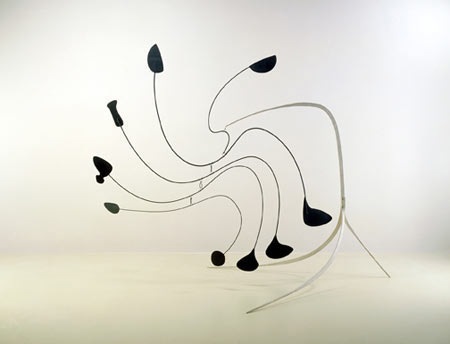
Part aerial act, part cinched weight tethered to the world, “Art: Form, Balance, Joy” is spectacular. It serves as reminder that, in large part, our work as humans is to hone the process of what the German philosopher Martin Heidegger, called “dwelling poetically.” This longing erupts as altar rails, in zendos and tribal rituals and, in rare moments, in those colossal architectural spaces we purposely concoct to invoke Muses — thus, the etymological root of the term, “museum.” Whether such swellings of the heart are reliably constellated in those structures is another matter. But, for now, we have abject magic in our midst.
Alexander Calder’s work is a shining display of our desire to wreck our hearts upon those centers that define everything we can — and can’t — name. The Greeks’ “omphalos,” the navel of the world, isn’t confined to Delphi. It travels with our inexplicable longing to beat ourselves senseless with Beauty. Calder, more spectacularly than most, is willing to oblige us by mauling us with loveliness.
“The Spider” (1940) functions almost as a branding motif for the show. It’s made of painted sheet metal and curving steel rods that remind us there’s magic in gravity. Larger, almost ovoid, shapes serve as a counterpoise to smaller, rounded shards. The entire piece is grounded and supported by curved rods. The work, as the name suggests, is reminiscent of the multiple legs of an arachnid. This wild and unwieldy piece is deft and light and, to borrow a term, shows us the unbearable lightness of an unlikely material that’s used in everything from armor to horse tack and airplane wings. Apparently, in capable hands, it can also become sheer lyricism.
“Three Bollards (Trois Bollards)” (1970) shows us how things intersect. “Bollards” is the term for posts sailors use to moor their crafts. And we, too, are given anchor by these pieces that seem vaguely mammalian. One discerns the shape of a head and sprawling legs. This kind of work, referred to as “biomorphic shapes,” are “stabiles” — as opposed to “mobiles” — and will almost certainly remind you of the contours in Joan Miró. They’re large and nuzzling pieces. They seem to nest. In fact, Calder gives us Felt Physics; his objects madly yoke desire and cerebration in much the same way a metaphysical poem might.
“Orange Paddle under the Table” (circa 1949) displays a fine balance that momentarily stuns us with the august weight imposed by symmetry. It’s an outward manifestation of a baffled gasp that reminds us of the simple laws that simultaneously keep planes aloft and make hair fall forward with irresistible allure. Plus, we’re reminded that whispers, not shouts, awaken us most pleasantly to the gorgeousness of the world.
“Do you see this lovely world?” seems to be the constant incantation of this show. And if Calder isn’t enough — and he is — you also have Giaciometti, Brancusi, Matisse and Picasso. This is stellar. And it really is, as the exhibition title implies, a triumvirate of form, balance and joy. And, of these, the greatest is joy.
